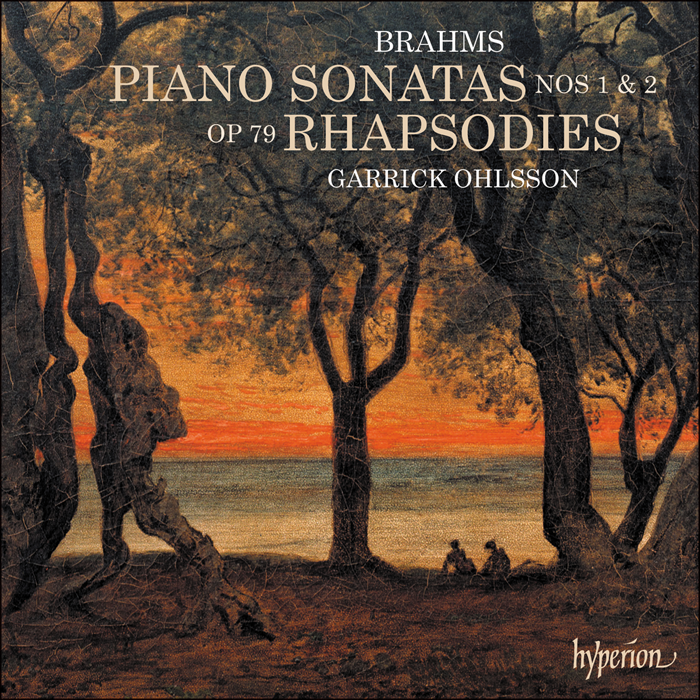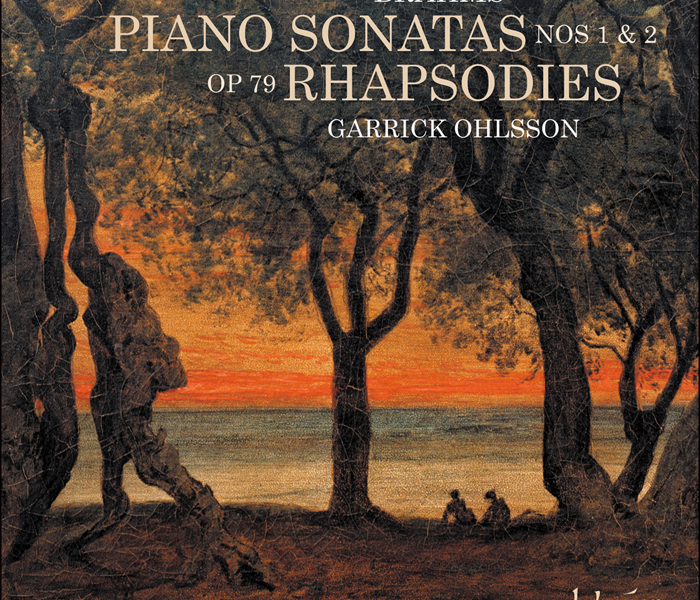Brahms: Piano Sonatas, Rhapsodies

Seated at the piano, he began to reveal wondrous regions to us. We were drawn into ever more magical spheres. In addition, the playing was absolutely inspired, transforming the piano into an orchestra of lamenting and loudly jubilant voices. There were sonatas, more like veiled symphonies; songs, whose poetry would be understood without knowing the words, although a profound vocal melody runs through them all; individual piano pieces, some of them demonic in nature while graceful in form; then sonatas for violin and piano, string quartets—and each work so different from the next that it seemed to stream forth from its own individual source. And then it seemed as though he were uniting them all like a stream roaring forth into a waterfall, with a peaceful rainbow above its tumultuously descending waves, and butterflies flitting about on the banks accompanied by the song of nightingales.
Schumann’s famous description of the young Brahms appeared in the Leipzig Neue Zeitschrift für Musik of 28 October 1853, in an article headed ‘Neue Bahnen’ (‘New paths’). Less than a month earlier, Brahms had called at the house of Robert and Clara Schumann in Düsseldorf. (‘He played us sonatas, scherzos etc. by him, all of them full of effusive imagination, intimate feeling and masterly form’, wrote Clara in her diary.) How many of the pieces Schumann mentions in his article have actually survived is open to question. Certainly, the always acutely self-critical Brahms destroyed the violin sonatas and string quartets; and the three now familar piano sonatas seem to have been preceded by others. The first of the published sonatas to be composed, in November 1852, was the one in F sharp minor, Op 2. However, the andante of the C major sonata, Op 1, based on the old German folk song ‘Verstohlen geht der Mond auf’, had been written some six months previously. More than forty years later, Brahms returned to the same song and used it to bring his collection of 49 Deutsche Volkslieder to an end. Thus, he told his publisher Fritz Simrock, his life’s work had come full circle: ‘The last of my folk songs and the same in my Op 1 represent the snake that bites its tail.’
All three of Brahms’s piano sonatas begin with a grandiose gesture flung across the entire compass of the keyboard. In the case of the Sonata No 1 in C major, the rhythm of the opening subject forcibly recalls the start of Beethoven’s ‘Hammerklavier’ sonata, Op 106. But there is a reference to another Beethoven sonata at work here too: Brahms almost immediately restates his first subject a whole tone lower, in B flat, just as Beethoven had done in his C major ‘Waldstein’ sonata. Brahms’s second subject, much of it played with the soft pedal, is an expressive, yearning idea in the key of A minor. It is this theme that permeates the long central development section, until Brahms manages to present it in contrapuntal combination with the assertive opening subject. The recapitulation is surprisingly restive and unstable, with the first subject passing through a variety of keys, and the second again appearing in the minor. Only in the closing moments does the music emerge triumphantly into the light of C major.
The slow movement is a series of variations on a melody Brahms describes as being based on an old Minnelied—an idea he also carried out in the andante of his Op 2 sonata. Brahms found these melodies in an anthology compiled in the 1830s by Andreas Kretzschmer and Anton Wilhelm von Zuccalmaglio under the title Deutsche Volkslieder mit ihren Original-Weisen (‘German folk songs with their original melodies’). Brahms had the words of the song printed beneath the opening bars of his slow movement:
Verstohlen geht der Mond auf.
Blau, blau Blümelein!
Durch Silberwölkchen führt sein Lauf.
Blau, blau Blümelein!
Rosen im Thal,
Mädel im Saal,
O schönste Rosa!
Stealthily rises the moon.
Blue, blue flower!
Its way leads through silver cloudlets.
Blue, blue flower!
Roses in the dale,
maiden in the hall,
O most beautiful Rosa!
After three increasingly elaborate and free variations, Brahms appends a calm coda—a sort of duet for tenor and soprano voices, suggesting the ‘two faithful hearts’ of the poem’s ending. The coda’s final bars, in a slower tempo, offer a foretaste of the theme of the scherzo, which follows without a break. As we shall see, Brahms carried out a similar scheme, though on a more elaborate scale, in his Op 2 sonata.
The scherzo of Op 1, in E minor, has a quicker trio in the sonata’s home key of C major. The trio’s rising phrases are presented in waves of increasing intensity and urgency, reaching a passionate climax before they subside, and a rushing scale sends the music hurtling into the reprise of the scherzo.
The rondo finale is based on a rhythmically transfigured version of the first movement’s opening subject. And so, just as the slow movement and scherzo are linked together, the sonata’s outer movements are interrelated. For the finale’s central episode in the minor, the music’s metre changes from three beats per bar to two, and Brahms presents a melody which was inspired by a poem of Robert Burns: ‘My heart’s in the Highlands’. This time, Brahms would have known the text through Schumann’s translated setting in his song cycle called Myrthen. He follows his textual source closely enough to make it possible for his melody to be underlain by Burns’s words, and the use of another folk-like text ties in the finale with the slow movement. As this episode comes to an end, Brahms alternates snatches of its melody with fragments of the main rondo theme, before the latter makes a full return. A coda in a quicker tempo brings the work to an exultant close.
Much as he had done with regard to the outer movements in the Op 1 sonata, Brahms carried out a scheme of unification between the two middle movements of the Sonata No 2 in F sharp minor, Op 2. The andante was inspired, as Brahms confided to his composer friend Albert Dietrich, by another old Minnelied, ‘Mir ist leide’ (‘I am pained’). The last of the four variations that go to make up this second movement sees the melody transformed from minor to major, and two seemingly conflicting elements unfold simultaneously: the pianist’s left hand plays the melody ‘sempre molto sostenuto’, while above it the right hand has a series of panting phrases played ‘con molt’ agitazione’. The latter are an echo of the opening movement’s passionate second subject, and they make a reappearance in the parallel subject of the finale. Meanwhile, with the third movement, which follows without a pause, Brahms returns to the minor and presents what is at one and the same time a fifth variation and a scherzo in its own right. It is a highly original stroke, and all the more remarkable when we bear in mind that the sonata is the work of a nineteen-year-old composer. Following the scherzo’s more relaxed trio, with its resonating horn calls, only the first half of the scherzo returns in its original form. The remainder finds its material surmounted by grandiose trills, as if in anticipation of the closing moments of the finale.
The outer movements, with their far-flung keyboard gestures, provide a vivid illustration of what Schumann meant when he called Brahms’s sonatas ‘veiled symphonies’. Once the forceful double octaves of the work’s beginning are over, a mysterious new idea appears deep in the bass of the piano. The new idea provides the generating force behind the remainder of the exposition—first, in the guise of an accompaniment to the breathless phrases of the second subject’s opening stage; and then, in inverted form, as an impassioned melody which draws the exposition towards its close. It is characteristic of Brahms’s lifelong desire to create music which evolves constantly that the recapitulation emerges seamlessly out of the central development section, with the music only finding its way back to the home key at the reprise of the main subject’s second half.
As he was later to do in his F minor piano quintet and his first symphony, Brahms prefaces the finale with a slow introduction. In this improvisatory beginning we find the sinuous shape of the finale’s main subject anticipated in slow motion, as well as a series of trills and sweeping scales that will return in the sonata’s closing moments. The outline shape of the movement’s main theme is taken over into the ‘zigzag’ figuration of the left-hand accompaniment to the incisive second subject. Brahms brings the exposition to a close with a powerful series of sustained chords that finds itself transformed at the start of the central stage of the piece into a mysterious moment of stillness, before the full force of the development section is unleashed. At the end, the music’s tension dissolves in a slow coda in the major, offering a return to the trills and improvisatory flourishes of the movement’s beginning.
When Brahms’s F sharp minor sonata appeared in print, in 1854, it bore a dedication to Clara Schumann ‘in admiration’. That dedication was not made without some trepidation on Brahms’s part. At the end of November 1853, he wrote to Schumann, asking: ‘May I set your wife’s name at the head of my second work? I hardly dare, yet I should so much like to give you a small token of my reverence and gratitude.’ And the following February, in his earliest surviving letter addressed to her, Brahms confessed to Clara: ‘I have dared to put your name at the head of the sonata. May you not find this as immodest as I now do; I hardly dare send it to you.’ Thus, Brahms’s Op 2 sonata may be said to mark the start of a relationship that lasted until Clara Schumann’s death more than forty years later, on 20 May 1896—less than a year before Brahms himself died.
The 2 Rhapsodies, Op 79, were composed in 1879—more than a quarter-century after Brahms’s piano sonatas. The impulsive opening subject of the B minor first of the pair is followed by a tender pianissimo melody which is soon brushed aside by the forceful return of the initial theme. The new melody, so briefly glimpsed at this stage, forms the basis of the consolatory middle section in the major. It makes a further return, this time in the left hand, during the coda which follows the reprise of the first section.
The second rhapsody, in G minor, is actually a sonata movement in itself, complete with a repeat of its exposition. The exposition’s final stage is accompanied by a constantly rocking minor second, or semitone, in an inner voice, and the same unchanging rocking motion casts its influence over the entire second half of the central development section. It returns, too, in the final moments of the piece, where it gradually decelerates and fades away, before a full-blooded final cadence brings proceedings to an abrupt close.
Misha Donat © 2021
Critical acclaim
“Ohlsson has a wonderful feeling for Brahms’s very special sound-world, which runs from craggy monumental force to the soft-edged mystery that emerges here and there, especially in the beautiful middle section of the second of the two Rhapsodies.”
“Ohlsson’s characteristic style, with ringing high notes in the top range of his Steinway, is fully on display here, and even listeners who don’t always appreciate that may find it uniquely well matched to this music. This pianist’s new investigations of Brahms in his old age are proving well worth listeners’ attention.”
- Release Date:
- April 28, 2021
- Number of Discs:
- 1
- Label:
- Hyperion Records Limited
- Copyright:
- (C) 2021 Hyperion Records Limited
- Total Length:
- 69:11
